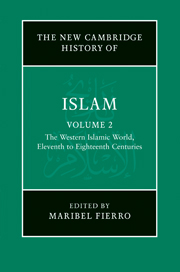Book contents
- Frontmatter
- Introduction
- PART I AL-ANDALUS AND NORTH AND WEST AFRICA (ELEVENTH TO FIFTEENTH CENTURIES)
- PART II EGYPT AND SYRIA (ELEVENTH CENTURY UNTIL THE OTTOMAN CONQUEST)
- PART III MUSLIM ANATOLIA AND THE OTTOMAN EMPIRE
- 10 The Turks in Anatolia before the Ottomans
- 11 The rise of the Ottomans
- 12 The Ottoman empire (tenth/sixteenth century)
- 13 The Ottoman empire: the age of ‘political households’ (eleventh–twelfth/seventeenth–eighteenth centuries)
- 14 Egypt and Syria under the Ottomans
- 15 Western Arabia and Yemen during the Ottoman period
- PART IV NORTH AND WEST AFRICA (SIXTEENTH TO EIGHTEENTH CENTURIES)
- PART V RULERS, SOLDIERS, PEASANTS, SCHOLARS AND TRADERS
- Glossary
- Bibliography
- Index
- References
10 - The Turks in Anatolia before the Ottomans
from PART III - MUSLIM ANATOLIA AND THE OTTOMAN EMPIRE
Published online by Cambridge University Press: 28 March 2011
- Frontmatter
- Introduction
- PART I AL-ANDALUS AND NORTH AND WEST AFRICA (ELEVENTH TO FIFTEENTH CENTURIES)
- PART II EGYPT AND SYRIA (ELEVENTH CENTURY UNTIL THE OTTOMAN CONQUEST)
- PART III MUSLIM ANATOLIA AND THE OTTOMAN EMPIRE
- 10 The Turks in Anatolia before the Ottomans
- 11 The rise of the Ottomans
- 12 The Ottoman empire (tenth/sixteenth century)
- 13 The Ottoman empire: the age of ‘political households’ (eleventh–twelfth/seventeenth–eighteenth centuries)
- 14 Egypt and Syria under the Ottomans
- 15 Western Arabia and Yemen during the Ottoman period
- PART IV NORTH AND WEST AFRICA (SIXTEENTH TO EIGHTEENTH CENTURIES)
- PART V RULERS, SOLDIERS, PEASANTS, SCHOLARS AND TRADERS
- Glossary
- Bibliography
- Index
- References
Summary
Byzantium and the Turks before the Turkish invasion
From Constantinople the Byzantine emperors looked across the Bosphorus to Anatolé, Greek for ‘the land of the rising sun’. Anatolé, or Anatolia, roughly the present area of Asiatic Turkey, was the heartland of the Byzantine empire in the eleventh century CE. Favoured with a wealth of natural resources, several natural harbours on the Black Sea, the Aegean and the Mediterranean, and many well-watered fertile valleys, Anatolia gave rise to countless villages and small towns as well as numerous large cities, most of which were connected with the major trade routes of the Middle East. All this ensured that it was the richest and most populous part of the empire. Indeed, for Muslims the word for Byzantium, ‘al-Rūm’ (Rome), was virtually synonymous with Anatolia.
Byzantium had long been familiar with Arabs and Islam, but distance had precluded much knowledge of the Turks. Byzantium had made diplomatic contact with Central Asian Turks as early as the sixth century CE and later the movement of Turkic peoples across the steppes north of the Black Sea brought them to the empire’s borders in eastern Europe. The first major encounter with Muslim Turks occurred in the third/ninth century. When the caliph al-Muʿtaṣim (r. 218–27/833–42) made an attempt to capture Constantinople in 223/838, he amassed several armies consisting mostly of Turks and directed them towards Ankara, which he conquered along with Amorium. Al-Muʿtaṣim had recruited them from Central Asia.
- Type
- Chapter
- Information
- The New Cambridge History of Islam , pp. 299 - 312Publisher: Cambridge University PressPrint publication year: 2010
References
- 2
- Cited by

